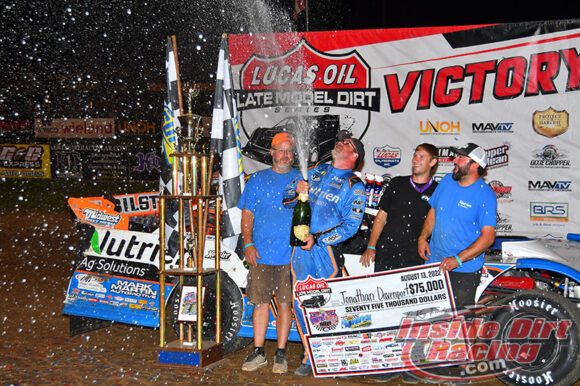The past couple of seasons have shown that dirt racing is clearly in a time of transition. Significant changes have been and are being made to a form of motorsports that has been, at times, very set in its ways. So for better or for worse, this form of motorsports is being pulled, perhaps kicking and screaming, into a new era. Years from now, those who label themselves as enthusiasts of this type of racing will likely look back on the early 2020s as a watershed time the various forms of competition that take place on clay surfaces.
Many of the changes now being seen in dirt racing were forced on to the sport by necessity during the Covid-19 outbreak and the resulting shutdowns caused those whose livelihoods are tied to racing to think of new ways to create revenue in a time when doing so was difficult for virtually every aspect of life. Some of those changes have disappeared while others not only continue but have flourished.
The most obvious change in dirt racing has been the seemingly exponential expansion of live streaming events. Whether it be Dirt Late Models, Sprint Cars, Modifieds, Midgets or even local racing divisions, there is hardly a racing event that cannot be viewed on a screen from just about anywhere that has access to the internet. The fact that these web-based services have continued to proliferate over the past couple of seasons would seem to be an indication that there is money to be made, or at least the prospect of profit, or else there would not be as many streamers as there are.
While it might be argued that streaming is either helping or hurting the tracks, there is no doubt that the way dirt racing is viewed has definitely been altered. In years past, if someone wanted to watch a race from a particular track, they had to actually go to that track. Now, events from hundreds of miles away can be seen live from the comfort of a sofa. Some argue that such helps the tracks by providing greater exposure and thus greater interest by viewers in someday attending a race in person while others contend that streaming takes the here-and-now revenue away from tracks by providing fans with the option of staying home.
Either way, it cannot be argued that the change is real. After a few more years of being allowed to play out, followers of dirt racing may look back and declare the addition of streaming to have been the most sweeping change to have ever hit the sport.
Along with that explosion of live broadcasts has come greater exposure for dirt racing than at any other time in its history. Drivers have reported that they are finding themselves noticed in public places away from race tracks more frequently than in the past. The stars of the sport are asked to make more appearances and cars are being used in promotions that a few years ago would likely not have been considered.
Adding to those opportunities are the extraordinary achievements of particular drivers that have drawn the attention of even those outside of the dirt racing world. 2021 NASCAR Cup Series champion Kyle Larson has helped draw fans of other types of racing to this form of motorsports by entering Sprint Car, Late Model, and Midget shows and performing at high levels. Further, headline grabbing performances by drivers such as Brandon Overton when he won multiple features at Eldora Speedway in 2021 and Jonathan Davenport when he captured the Eldora Million in 2022 have drawn added interest.
Another aspect of recent years that embodies the “new” modern day form of dirt racing has been the emergence of numerous events paying large amounts of money. More features paid winners $25,000 or more this past year than ever before in the history of the sport. For years, drivers and teams have pointed out that purses had seen little change for two or three decades but in 2022 promoters and the various series stepped up to offer the largest payouts ever.
With a limited number of weekends on the calendar but a growing number of big shows that series and promoters want to run, some events have had to be scheduled for days of the week that have not typically been considered as traditional race dates. Over the past couple of seasons, there have been an ample number of features contested on Mondays, Tuesdays or even Wednesdays.
The XR Super Series and the Castrol FloRacing Night in America Series, for the most part, targeted those dates that on some occasions coincided with race weekends being staged by the Lucas Oil Late Model Dirt Series or the World of Outlaws CASE Construction Late Model Series. Doing so, along with significant payouts, helped to draw competitors and fans.
Concerning the national tours, some drivers who had traditional followed and had even won championships opted to go where the money was on a particular weekend rather than stick with one series. The prevailing thought of just a few years ago was that a driver had “made it” if he followed one of the national tours as a regular. Not racing on a series was yet another change in the way of thinking in Dirt Late Model racing to have occurred over the most recent campaigns.
Because of the need to keep top stars on tour, the series are in the process of making significant changes to payout structures for their regulars within their point standings. More money than ever before is now being offered not only to the champions but to those who finish further down in the standings.
Change isn’t always easy or welcomed. The old adage of “If it ain’t broke, don’t fix it” is one that is often quoted when a new way of doing things is proposed. However, if some of those old ways aren’t adjusted in time, they develop into things that are, in fact, broken. Racing in all of its forms has been reluctant to change its ways but has occasionally found itself in positions in which it had to adapt to new ideas. This appears to be one of those times.
The Covid pandemic caused a great deal of consideration to be put into how we had done things in the past and how we were going to have to refresh those ideas going forward. Racing has been as affected by the shutdowns, shortages and reconfiguring that has gone on since 2019 as any other form of business. As the points made above show, the sport has changed drastically since and there are likely to be more adjustments in the works.
At the age of 55, I fit into the category of people who typically want the old ways to remain in place. But there comes a time in which that is no longer possible. Going backwards is not an option. As far as racing goes, streaming services, higher paying events, and changed mindsets as to what the ideal schedule might be are all part of those adjustments. Now it’s time to see just how successful(or unsuccessful) those new ways of doing things will prove to be.
Please consider also reading:
Michael Chilton makes the most of 2022 with double Iron-Man titles
Respond to this post on Twitter by following @RichardAllenIDR and @MichaelRMoats or by liking the InsideDirtRacing.com Facebook page.
Also, NASCAR and pavement racing fans can check out InsideCircleTrack.






